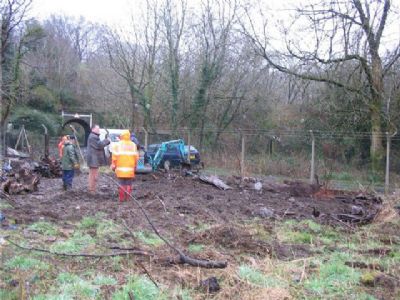 Taff's Well and Nantgarw Allotments and Community Garden Project | sitemap | log in Taff's Well and Nantgarw Allotments and Community Garden Project | sitemap | log in
|
 |
||
| This is a free Spanglefish 1 website. | ||
Clearing a New Allotment - How to Clear a New Allotment(Text reproduced by permission of theAllotment Vegetable Growing Association)
So where to start?
First thing to do is take a look at what weeds are growing. Nettles, docks, buttercups and daisy all indicate that your soil is acidic. Docks love damp conditions. Mares or Horses Tail (Equistum Arvense) also likes acidic soil.
You will now have an idea of what your soil is like. Weeds are a good indication of soil fertility. Lush tall weeds indicate good fertility. Pretty obvious really.
What not to do
I have seen a few people take on a plot covered in docks and happily run a rotovator over it. The perennial weeds will grow from a root fragment and so chopping them up and tilling the soil is a great way to propagate them and ensure you have a plot absolutely covered in weeds a few weeks later. At this point some give up the plot!
What to do to Clear the Plot

Chemical Gardeners
Spray the plot with Roundup or suchlike, wait for the weeds to die and then rotovate. Sounds pretty simple, certainly less effort but you need to trust the chemical companies information and do not mind growing food on the soil you just sprayed with complex chemicals.
Organic Gardeners
Hard work awaits you! First decide how much time and energy you have. There is no way I could clear a plot in one go or even one week. You can cover sections of the plot with thick plastic, carpets or tarpaulins (if you have them) and this will hold back growth until you can get to the section. If you leave an area covered for a year or so then most of the weeds will die.
Personally I do not want areas out of production that long so I just use covering as a holding method.
Now take a small section at a time, looking down 100 feet of weeds is enough to make anyone despair. I found 6 feet patches (15 feet wide) to be about right but those younger and fitter can do more.
Start by taking off the surface grasses and short rooted weeds with a spade – the resulting ‘turfs’ can be stacked to eventually form a loam. The deeper rooted perennials (like docks) need their roots digging out. These are the devil to deal with. I just added them to a cool compost heap and they happily grew on You can try chopping them (to weaken them) and add them to a hot compost heap.Other methods which do work are drowning in a barrel of water for 3 weeks or tying up in a plastic bin bag for a few months.
Having completed clearing, I then dig over with a fork. The purpose is to break up the soil and extract any weed roots. Watch out for bindweed – this is one that spreads from a small bit of root. A small stem is probably growing from a foot of tubular white root snaking along a few inches below the surface.
One exception to the rule is Mares Tail or Horse Tail. This wonderful weed has roots that go down to hades, well 1.5 metres anyway. The only thing I know to kill them is ammonium sulphamate, a weedkiller often sold for brushwood clearance. The problem with this is that you can not plant for 8 to 12 weeks after use. It's not approved for organic growers but it is a very safe and simple herbicide.
Moving along
As you clear a patch, consult your overall plan and prepare the ground accordingly. If it’s getting late in the season then consider a green manure. As you get towards the end of your plot you will probably find weeds sprouting behind you. They never stop! Most of these will be annual weeds whose seeds have been germinated by your clearance exposing them. Don’t worry – you can just hoe them off.
|    |
|
 | ||